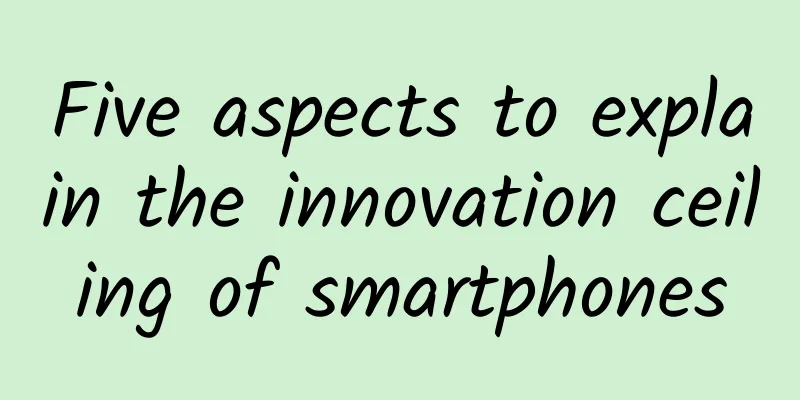Five aspects to explain the innovation ceiling of smartphones

|
It is not a new view that Apple has lost its innovation. Some time ago, many people joked that the newly released iOS 14 was "hollowing out Android". In fact, it is really a bit difficult for Apple. In recent years, leapfrog innovation in the field of smartphones has almost disappeared. There are more micro-innovations or just regular technological iterations.
Some people may say that folding screen technology is a big innovation, such as the Samsung Fold series, Huawei Mate X series, and FlexPai series. Although these machines have a certain market, in terms of popularity and practical value, the current performance of folding screen technology is very average. Or the high refresh rate of the screen that suddenly became popular this year, with the highest even reaching 144Hz, is actually just a technological iteration, not an innovation. Does 5G count? I'm afraid not. 5G is just a regular iteration of smartphone hardware. Its performance over the past year or the degree of surprise it has brought to users is far less than the leap from 3G to 4G. After all, many experts believe that the emergence of 5G is actually more of a service to the major upgrade of the B-side industrial chain. It is actually an upgrade of communication technology rather than an upgrade of smartphones. Have smartphones really hit the ceiling of innovation? We can briefly discuss this from five aspects: camera, battery life, appearance, chip, and system. Camera: Far from a SLR In the past two years, Huawei's P series began to focus on the camera system of mobile phones, which set off a trend. All companies racked their brains to make the camera stronger and more distinctive. Last year, Huawei first equipped the P30 Pro with 5x optical zoom and 50x digital zoom, and then Xiaomi cc9 Pro was equipped with 100 million pixels for the first time. This year, Samsung S20 Ultra offered 100x digital zoom, and Huawei p40 pro+ directly took out 10x optical zoom. Judging from the products, everyone has different ideas about making cameras. For example, Xiaomi wants to increase the number of pixels, while Huawei wants to increase the distance. As a result, manufacturers have been engaged in verbal battles and public relations wars from time to time over the correct direction of cameras, and the gunpowder smell has never disappeared. Whether it is 10x optical zoom or 100 million pixels, judging from the reviews of subsequent products, many digital bloggers and professional photographers have considerable controversy over this. A soul-searching question is: How useful are these extreme functions of high-end technology? The answer is that it is only useful for a few people, or in other words, it is not used in most scenarios. So we can also see that only the top models such as S20 Ultra and P40 Pro+ are equipped with these features, and the price is not cheap, so there are not many early adopters. The good news is that the average quality of mobile phone cameras priced above 1,000 or 2,000 yuan can basically cover most of the daily life needs of ordinary people. The occasional camera improvements that can briefly excite us are basically targeted at extreme scenes. Judging from certain standards, such as anti-shake performance, color grading level, night shooting ability, etc., the comprehensive capabilities of mobile phone cameras have improved significantly in recent years, and can even take pictures of the moon and solar eclipses, and the upper limit of shooting has also been raised. But the question remains: when will small and thin mobile phones beat SLR or mirrorless cameras? This may require the superposition of multiple leapfrog innovations. Battery life: Just charge faster In the past two years, Android phones have made significant progress in battery life, mainly in terms of battery capacity and charging speed. As for battery capacity, even for phones priced at 1,000 yuan, the capacity is generally around 3,000 mAh, and for mid- to high-end models, it is generally around 4,000 mAh. Generally speaking, charging once a day is not stressful. Today, most people are not so sensitive to the size of the battery when choosing a phone, because the rapid iteration of charging technology has made capacity less important to a certain extent. This year is also a year of rapid iteration of fast charging. Judging from the flagship phones of several major manufacturers, wired fast charging or wired super fast charging is already standard, generally around 40W-65W, such as the 50W flash charging of the Xiaomi 10 pro series, the 44W flash charging of the vivo X50 Pro+ series, and even the 65W super flash charging of the OPPO Reno4 Pro series. In terms of wireless charging, charging technology is also evolving rapidly. For example, the Xiaomi Mi 10 Pro series already supports 30W wireless flash charging, and the Huawei P40 Pro series supports 27W wireless super fast charging. Even for mobile phones with a battery capacity of 4000 mAh or above, the advancement of fast charging technology has shortened the full charging time to more than 30 minutes. To some extent, the current fast charging technology has largely offset users' concerns about battery life and battery capacity. Even heavy users who consume 80% of the power in half a day can replenish it in a very short time. Although there has been no progress in mobile phone battery materials for many years, and the recently popular graphene battery has not yet been commercialized by any manufacturer, the iteration of charging technology has made most users have no complaints about battery life. In the short term, the optimization of battery life still lies in fast charging technology and energy consumption, and major innovations related to batteries are still difficult to appear. Appearance: Color and back cover The emergence of touch-screen phones should be one of the biggest innovations in the history of mobile phones. The emergence of touch screens not only created more possibilities for mobile phones in terms of appearance, but also changed the way people interact with mobile phones, and to a certain extent left huge space for the subsequent development of mobile phone software. In the past two years, the focus of mobile phone appearance was still on full screen, and who had the highest screen-to-body ratio. Some manufacturers have made double-sided screen solutions, such as Nubia X, and some have made pop-up cameras, such as OPPO Find X. Now, the situation has changed again, and it is rare to see a manufacturer making a big fuss about the screen-to-body ratio at the launch of flagship phones. Judging from the phones of various price ranges released this year, the most intense competition in appearance is still in color and material. Huawei P40 series has Frost Silver, Nova 7 series has "Color 7", OPPO Find X2 Pro series has Bamboo Green, and OnePlus 8 Pro has Blue. In terms of material, in addition to plastic and glass back covers, more and more manufacturers are beginning to try back covers made of ceramic, plain leather and other materials. In terms of appearance, the most unconventional ones are gaming phones, such as Black Shark 3 and Red Magic 5G. Their design adopts a streamlined design style that fits the game, in order to create a cool and fast visual impression for users. In terms of appearance, the two major development trends in the future are the decreasing screen-to-body ratio (variable camera positions) and the increasing number of colors. Despite the practice of using a second screen, the appearance of smartphones has basically been finalized, and even foldable phones have not changed much in appearance. Chips and systems: step-by-step upgrades Thanks to Moore's Law, the performance of mobile phone chips has been steadily improving over the past few decades. Now, due to the demand for 5G upgrades, the integration of 5G capabilities by major chip manufacturers has also made significant progress in the overall performance of chips. Last year, Qualcomm, HiSilicon, and MediaTek all launched their own 5G chips, either for their own mobile phones or to grab manufacturers' users. At present, the emergence of 5G chips only gives mobile phones 5G capabilities, which is mainly reflected in upload and download speeds. The logic of improving chip performance, such as reducing energy consumption or increasing computing power, is still similar to the 4G era, depending on the AI capabilities and chip design capabilities of each company. Moreover, 5G chips have only been around for a short time, and there are still many areas that need to be improved in the 5G experience, such as stability, dual SIM dual standby, etc. With the continuous popularization of 5G base stations, this situation will gradually improve. The system should be the most innovative part of the mobile phone. In the past two years, whether it is Android or IOS, more innovations have been made in interaction, privacy, fluency, etc. At the Android system level, each manufacturer has made its own customized version, forming its own characteristics, such as Huawei EMUI, Xiaomi MIUI, Meizu Flyme, OnePlus Hydrogen OS, etc. System experience is a matter of opinion. The fluency and UI design of the iOS system have always been a model, but EMUI, MIUI, etc. are also catching up in different ways, or even surpassing. But at present, the lack of innovation in iOS may already explain some problems, that is, there is indeed a big bottleneck in innovation at the system level. Final Thoughts In the first year of 5G, manufacturers released new phones in a very tight schedule. There is nothing wrong with seizing the market, but if you carefully consider most of them, you will find that they are just different combinations of existing solutions, and there are few truly exciting innovations. To some extent, this is not their fault. How can something that does not exist in the supply chain and laboratory appear on the terminal? Even so, it is undeniable that micro-innovation has contributed to the efficiency and experience of mobile phones. 5G is faster, but maybe a little slower will give us more time to see the future clearly. |
<<: The three major operators have started the construction of 5G message commercialization platform
>>: Apple wants the iPhone to replace your passport, driver's license and other IDs
Recommend
Hot search! Can garlic break a knife? It's much more powerful than this
Recently, an incident in which a certain brand of...
How to balance Swift and Objective-C? Let's look at @objc and Dynamic
Although the original intention of Swift language...
Android development in 2019, my journey of change
[[264555]] Mobile development has not cooled down...
New Baojun XiaoBiu smart car released, Suning XiaoBiu takes the lead in realizing "smart interconnection between people, cars and homes"
"People, Cars, Homes, Life", on Septemb...
What does it mean when beauty relies on beauty?
Beauty leans on beauty, what exactly is beauty le...
There are two ways of thinking for good operations
For a long time, we like to talk about product th...
iPhone 11 upgrade iOS 15.5 saves more power than iOS 15.4, and those who have used it all say it’s good
Apple officially released the iOS15.5beta1 test v...
Knowing more drainage channels is not as good as understanding these 3 drainage principles!
User growth is almost the ultimate proposition of...
WeChat Mini Program Zero-Base Development Tutorial, How to Develop WeChat Mini Program with Zero Base?
Q: WeChat Mini Program Zero-Base Development Tuto...
How to finish a month's worth of articles in just one hour? Only 6 steps!
The source of content has always been the most tr...
Is Dong Mingzhu's car-making worthy of Wang Jianlin's 500 million yuan and can it become another pride of domestic cars?
Do you have Gree Electric Appliances at home? I be...
I have something stuck in my teeth again. What should I use to get the leaf out?
Although dentists have always regarded brushing t...
Animals can't stand the heat either: millions of years of evolution completed in just a few decades
Climate change is accelerating, and animals are f...
91 Ten Articles: Ping An suspends new Tesla insurance, and Ideal Auto is going to compete head-on with Huawei
1. After a series of car crashes, some provinces ...









